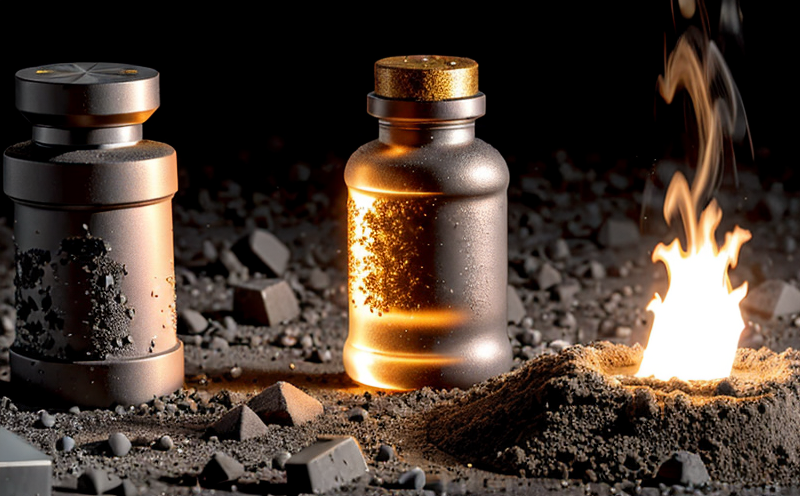Radiation-Induced Material Degradation Testing
Understanding the effects of radiation on materials is crucial in various sectors such as aerospace, nuclear energy, and defense. Radiation-induced material degradation (RIMD) testing plays a pivotal role in ensuring that materials used under high-radiation environments maintain their integrity and performance over time. This testing evaluates how different materials degrade when exposed to ionizing radiation, which can lead to embrittlement, cracking, or other forms of damage.
The process involves exposing specimens to controlled levels of gamma, beta, or neutron radiation in a laboratory setting. The choice of radiation source and the type of specimen determine the specific test configuration. For instance, materials used in nuclear reactors require testing with high-energy gamma rays, while those in satellite components might be exposed to simulated cosmic radiation.
Materials such as polymers, metals, ceramics, and composites are frequently subjected to RIMD testing. The tests simulate real-world conditions where these materials may encounter significant levels of ionizing radiation. This helps manufacturers and engineers predict the long-term reliability and durability of their products, ensuring that they can withstand harsh environments without failing prematurely.
The methodology involves precise control over exposure parameters such as dose rate, total absorbed dose, and temperature. Specimens are prepared according to standard procedures, often involving cutting or shaping them into specific dimensions suitable for the test rig. After exposure, physical and mechanical property tests are conducted to assess changes in material properties.
Commonly measured properties include tensile strength, elongation at break, impact resistance, and hardness. These tests provide a comprehensive understanding of how radiation has affected the material’s performance. Additionally, microscopic examination using techniques like scanning electron microscopy (SEM) can reveal microstructural changes that are not apparent through macroscopic testing alone.
The results from RIMD testing are vital for several reasons. Firstly, they inform the design and selection of materials used in high-radiation environments. Secondly, they guide the development of protective coatings or treatments to enhance material resistance to radiation damage. Lastly, these tests help in establishing quality standards that ensure consistent performance across different batches of materials.
For example, in aerospace applications, understanding RIMD can prevent catastrophic failures during space missions. In nuclear energy sectors, it ensures the safety and longevity of reactor components. By incorporating this testing into their development processes, industries can make informed decisions about material selection and design, leading to safer and more reliable products.
- Customer Impact: Reduced risk of product failure in critical applications like space exploration or nuclear power generation.
- Safety Assurance: Enhanced reliability through better understanding of materials' behavior under radiation stress.
- Regulatory Compliance: Meeting standards and regulations that mandate testing for radiation exposure.
Scope and Methodology
The scope of RIMD testing includes evaluating the impact of ionizing radiation on various materials used in high-radiation environments. The methodology involves exposing specimens to controlled levels of radiation, followed by a series of tests to assess changes in material properties.
Material types commonly tested include polymers, metals, ceramics, and composites. Each type has specific characteristics that make it suitable for different applications, and the testing process is tailored accordingly. For instance, polymers are often used in packaging materials due to their flexibility, but they can degrade rapidly under radiation exposure.
The exposure parameters such as dose rate, total absorbed dose, and temperature are carefully controlled to simulate real-world conditions. The dose rate determines how quickly the material is exposed to radiation, while the total absorbed dose specifies the cumulative amount of radiation the specimen will encounter. Temperature is also a critical factor, as it can influence both the chemical reactions within the material and its mechanical properties.
After exposure, the specimens undergo a range of tests to evaluate changes in their physical and mechanical properties. Tensile testing measures how well the material stretches before breaking, while impact testing assesses its ability to absorb energy during an impact event. Hardness testing provides information about the material’s resistance to localized indentation.
Microscopic examination using techniques like SEM allows for detailed analysis of any structural changes that may have occurred within the material. This can help identify specific mechanisms by which radiation causes degradation, such as cross-linking in polymers or embrittlement in metals.
Why Choose This Test
Selecting RIMD testing is essential for industries that rely on materials to perform reliably under high-radiation environments. By choosing this test, organizations can gain valuable insights into the behavior of their materials when exposed to radiation. This knowledge allows them to make informed decisions about material selection and design, ultimately leading to safer and more durable products.
One key benefit is the ability to predict long-term performance. Without RIMD testing, manufacturers run the risk of selecting materials that may degrade prematurely or fail under operational conditions. By conducting these tests early in the development process, companies can identify potential issues before they become major problems.
Radiation-induced material degradation testing also helps ensure regulatory compliance. Many industries are subject to stringent regulations that require materials used in high-radiation environments to meet specific standards. RIMD testing provides the data needed to demonstrate compliance with these regulations, thereby reducing the risk of legal challenges or product recalls.
Moreover, this testing can enhance safety by identifying materials that may pose risks if they degrade over time. For example, in nuclear applications, a material failure could have catastrophic consequences. By using RIMD testing to evaluate potential issues early on, manufacturers can take proactive steps to mitigate these risks.
In summary, choosing RIMD testing is not just about meeting regulatory requirements; it's about ensuring the safety and reliability of products in critical environments. This testing provides crucial information that helps companies make informed decisions, ultimately leading to better-performing materials and safer applications.





